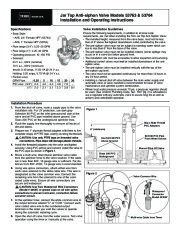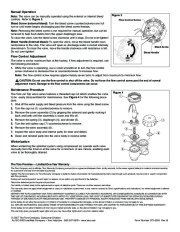From inside (document excerpt):
Jar Top Anti-siphon Valve Models 53763 & 53764 Installation and Operating Instructions Specifications · Body Style: · AVB, 3/4 ” Female NPT (53763) · AVB, 1 ” Female NPT (53764) · Flow range (3/4 “): 0.2520 GPM · Flow range (1 “): 0.2530 GPM · Operating pressure: 10150 PSI · Solenoid: 24 V a.c., 60Hz (nominal) 19 V a.c., 60Hz (minimum) Inrush: 0.40 amps, 11.50 VA @ 24 V a.c. Holding: 0.20 amps, 5.75 VA @ 24 V a.c.
Lawn Sprinkler User Manual Free Download. Irrigation Free Instruction Manual Download PDF.
· Friction Loss: GPM Flow 0.25 5 10 15 PSI Loss (3/4 “) Valve Installation Guidelines Ensure the following requirements, in addition to all local code requirements, are met when installing the Toro Jar Top Anti-Siphon Valve: · The installed height, measured from the valve base, must not be less than of 6 ” above the highest downstream outlet controlled by the valve. · The anti-siphon valve must not be subject to standing water which can rise to less than 6 ” from the base of the valve. · The anti-siphon valve must not be installed indoors (some spillage may occur) or in a valve box below ground level. · The installation site must be accessible to allow inspection and servicing. · Additional control valves must not be installed downstream of the antisiphon valve. · The anti-siphon valve must be installed vertically with the top of the anti-siphon cap level. · The valve must not be operated continuously for more than 12 hours in any 24-hour period. · Installing a manual shut-off valve between the main water supply and automatic valve or valve manifold is recommended for ease of valve maintenance and sprinkler system winterization. · Where local water pressure exceeds 70 psi, a pressure regulator should be used. (See Uniform Plumbing Code, Sec. 1007 [b].) It is advisable to use a regulator with any automatic valve to assure long life as well as uniform and controllable operation. 20 7.6 3.8 30 8.1 Installation Procedure 1. From the shut-off valve, route a supply pipe to the valve installation site. For UV protection, use dark gray Schedule 80 PVC on the inlet (pressurized) side of the valve and all PVC pipe installed above ground. Use Class 200 PVC on the underground sprinkler lines. 2. Flush the supply line thoroughly to remove all traces of dirt and debris. 3. Prepare two 1 ” slip/male thread adapters with three to five complete wraps of PTFE tape, evenly covering the threads. CAUTION: Use only PTFE tape on threaded valve connections. Pipe dope will damage plastic threads. 4. Install the threaded adapters into the valve and tighten securely. Using PVC primer and cement, install the valve to the PVC pipe as shown in Figure 1. 5. Route a multi-wire, direct-burial sprinkler valve cable from the sprinkler timer to the valve location. If the cable run is less than 800′, 18-gauge wire is sufficient. For distances from 800’2000′, 14-gauge wire is recommended. 6. Using wire splice connectors, attach either wire from each valve solenoid to the white cable wire. This wire is designated as the valve common wire. Connect the remaining wire from the solenoid to one of the colorcoded cable wires. Ensure all wire connections are secure and waterproof. CAUTION: Use Toro Waterproof Wire Connectors (Model # 53687) or grease caps on all wire splice connections to prevent corrosion, connection failure and short circuit. 7. At the sprinkler timer, connect the white common wire to the output terminal labeled “C ” or “COM. ” Connect each color-coded valve wire to the numbered output terminals in the order you wish the valves to operate during the automatic watering cycle. 8. Open the shut-off valve from the water source. Test valve operation using the timer or manually at the valve. Figure 1 Slip x Male Thread PVC Adapters 6 ” (minimum) SCH 80 PVC Pipe From Water Source Use SCH 80 PVC Above Ground Manual Shut-Off Valve Class 200 PVC Underground Figure 2 Valve Common Wire Waterproof Connector Model #53687 Multi-wire Cable from Timer Manual Operation Note: The valve can be manually operated using the external or internal bleed controls. Refer to Figure 3. Bleed Screw (external bleed): Turn the bleed screw counterclockwise one full turn or until water begins discharging past the bleed screw threads. Note: Removing the bleed screw is not required for manual operation, but can be removed to help flush debris from the upper diaphragm area.


 Toro Owners Manual - 1 of 2
Toro Owners Manual - 1 of 2 Toro Owners Manual - 2 of 2
Toro Owners Manual - 2 of 2